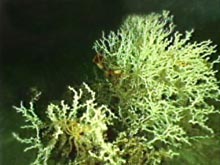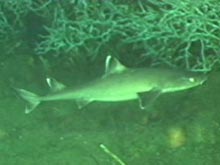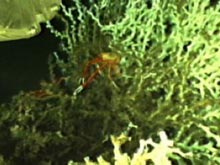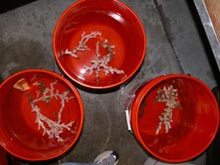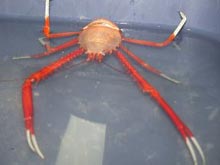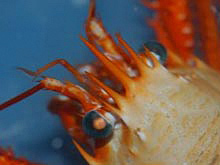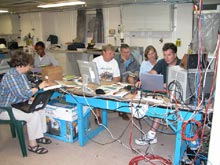
The first team of the day crowds around the video monitor in the main lab on the Ron Brown to annotate the video coming from the ROV during a dive. (From left to right: Suzanne Fredericq, Taconya Piper, Ron Hill, John Bratton, Julie Olson, and Doug Weaver) Click image for larger view.
More Residents of Viosca Knoll
September 24, 2003
Sandra Brooke
University of Oregon
Julie Olson
University of Alabama
After spending a day (two dives) looking for the apparently elusive, deep-water coral Lophelia pertusa and finding a single representative, how nice it was to launch the ROV (remotely operated vehicle) today into the midst of many Lophelia colonies. As the sun gently slipped over the horizon, the ROV slowly made its way through the warm surface waters of the Gulf to the ocean floor 1,484 ft below. Individual coral colonies dotted the visible landscape, and surprised bright red crabs were caught in the glare of our lights, startlingly colorful against the stark white of the corals.
Apparently less concerned with the intrusion of the light were the numerous brittlestars also residing on and around the corals. As the ROV swam up the gentle slope, more and more corals became visible and the ocean floor changed from solid mud to include patches of carbonate rock. Many of the corals were now in large clusters, or "thickets," with much of the base material for the thicket consisting of dead coral rubble, which is brown and so easily visibly distinguished. The occasional small shark or eel was caught meandering through the corals but seemed impressively uninterested in the behemoth of the ROV.
Small samples of the brittle Lophelia coral were carefully collected with the ROV’s manipulator arm and a crab and anemone were collected prior to recovering the ROV. Identification of the crab by Dr. Mary K. Wicksten of Texas A&M University indicated that it was Eumunida picta, an organism that has never before been reported from the Gulf of Mexico (click here for more on the newly discovered painted squat lobster.)
The Lophelia samples are destined for cold-water aquaria at the Oregon Institute of Marine Biology, where experiments on their behavior and physiology will allow us to learn more about the environmental constraints on Lophelia distribution.
The final dive of the day was spent exploring an area that the sidescan sonar data indicated might be a promising site to find well developed coral thickets. We peered with anticipation at the video monitors as the benthos came into view. We expected at any moment to see bright white tangled colonies of coral appear through the gloom. Unfortunately, all we saw was mud.
Undeterred, we set off along the transect, looking for some indication that a reef might be ahead of us. Corals need a hard, solid substrate to settle upon and grow, so the presence of exposed boulders and rocks are often a good indicator that corals might be nearby. They also like high current flows to deliver food and clean water, and current speed increases over topographical high spots such as boulders or the tops of mounds. The benthos, however, remained stubbornly and uniformly flat. Often venturing into the unknown can bring the thrill of an undiscovered ecosystem, or a new and bizarre animal, but sometimes all you find is mud. After three hours we gave up searching and brought the ROV to the surface. It was a disappointing result, but such is the nature of exploration, and tomorrow is another dive!
The near-24 hour ROV operation at Viosca Knoll resulted in great footage of some very diverse deep-sea habitats, from rather barren muddy bottom, to anemone gardens and carbonate mounds covered in sponges, anemones, corals, and various invertebrates, to lovely bushes of Lophelia pertusa with a variety of inhabitants such as fishes, squat lobsters, and sea stars. A great deal was learned about this special region in the Gulf of Mexico in a small amount of time, and as video images and sediment and coral samples are analyzed, our knowledge of Viosca Knoll will increase tremendously.
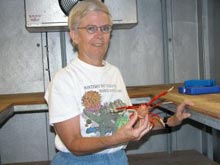
Mary Wicksten, an invertebrate biologist at Texas A&M University, holds the painted squat lobster collected at Viosca Knoll. Click image for larger view.
Painted Squat Lobster Discovered in Gulf
Mary Wicksten
Texas A&M University
The painted squat lobster, Eumunida picta, has been collected along the U.S East Coast and in the Straits of Florida. Although it has been photographed in the Gulf of Mexico before, it could not be identified with certainty. Many deep-sea animals are known to scientists only from preserved and faded specimens, so that a photograph cannot be matched with a technical description. To make matters more difficult, most of the technical descriptions are in old books and journals, some dating back to 1880.
By using a remotely operated vehicle (ROV), our group was able to collect an animal and bring it to the surface alive. Examination of the animal showed that it was a squat lobster, recognizable by the short abdomen (the “tail”) tucked under the body but able to flap, enabling the animal to scoot backwards. The animal also has long spines over the eyes and on the long pincers, and a small posterior set of cleaning legs tucked along the side of the body. The antennae are long and well equipped with sensory hairs. The eyes contain pigment, enabling the animal to detect slight seasonal changes in light intensity and any bioluminescence (“living light” from fishes or crustaceans) in the area. The distinctive feature of this particular squat lobster is the set of five long spines at the front of the body near the eyes. Although it is called a squat lobster, the animal is actually a distant relative of hermit crabs.
From photographs and previous records of squat lobsters, I suspect that the painted squat lobster lives among corals and not out on the muddy sea floor. If so, this would explain why it has not been collected before. Most deep-sea collecting has been conducted on the vast muddy sea floor of the Gulf of Mexico, not among rocks and deep-sea corals.






















